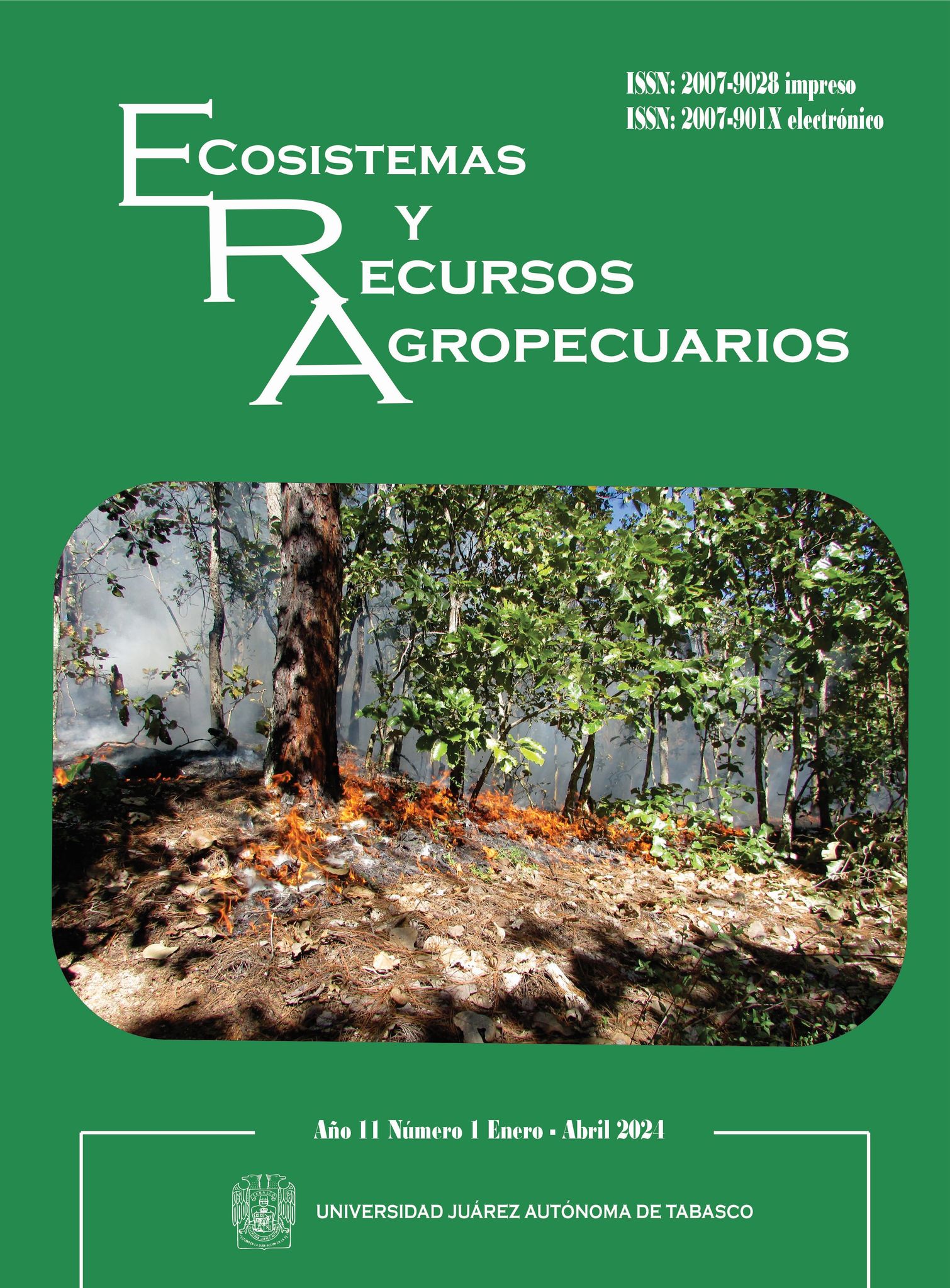Fertilization and nutrient demand NPK of Swietenia macrophylla King and Cedrela odorata L. in development
DOI:
https://doi.org/10.19136/era.a11n1.3832Keywords:
fertilization, Mahogany growth, Mexican cedar growth, nutritional demand, savannah soilsAbstract
Mahogany and cedar are native species of tropical America and are considered the most valuable tropical hardwoods in the world. Therefore, forest plantations have been established on a commercial scale, giving them a sustainable silvicultural management, being fertilization one of the most important practices. The objective of this work was to evaluate the effect of four doses of fertilization on the growth of early-stage mahogany and cedar in an acid savanna soil, as well as to determine the NPK nutrient demand of each species. Eight fertilization treatments were tested on the two species. The variables studied were total height and stem diameter, and measurements were taken during 10 months. To estimate nutrient demand, four complete trees were sampled and NPK concentration was determined in each tissue (leaf, stem and root). The results show that cedar presented greater growth in height and diameter. In the height variable in the cedar species, it was the one that showed significant statistical differences, being the treatment 17-17-60 with the amounts of 35 and 50 g with an increase of 177 cm. The amount of NPK nutrient demanded by both species presented a relationship in the following order N>K>P. The greatest extraction of N, P and K is carried out by the stem and to a lesser extent by the root. And in the case of the highest concentration of nutrient is found in the leaves. Cedar showed higher nutrient demand and better exploration of the rhizosphere tan mahogany.
Downloads
References
Alvarado HA (2015) Plant nutrition in tropical forestry. Pancel L, Kohl M (eds) Tropical Forestry Handbook. Springer. Berlin, Heidelberg. 91p. https://doi.org/10.1007/978-3-642-41554-8_105-2.
Aceves NLA, Rivera HB (2019) Clima. En: La biodiversidad en Tabasco. Estudio de Estado. Vol I. CONABIO. México. pp: 61-68.
Carvajal DA, Murillo CR, González RM, Fonseca GW (2021) Evaluación del crecimiento de Cedrela odorata L. en sistemas de agrosilvicultura de café en Pérez Zeledón, Costa Rica. Tropical journal of environment Science 55(1): 230-249. https://doi.org/10.15359/rca.55-1.
CONAFOR, Comisión Nacional Forestal (2005) Guía para la elaboración de la propuesta técnica forestal y ambiental. México. 86p.
CONAFOR, Comisión Nacional Forestal (2006) Datos a los bosques. Número de incendios forestales, Gerencia de Incendios Forestales, México. http://148.223.105.188:2222/gif/sni/%5fportal/index.php?option=com_content&task=view&id=51&itemid=65.
CONAFOR, Comisión Nacional Forestal (2012) Programa de Desarrollo de Plantaciones Forestales Comerciales, a 15 Años de su Creación. A. Fierros G. M. CONAFOR. Zapopan, Jalisco, México. 152p.
CONAFOR, Comisión Nacional Forestal (2020) El sector forestal mexicano en cifras 2019. Bosques para el bienestar social y climático. Zapopan, Jalisco, México. 100p.
Fonseca GW, Murillo CR, Ávila AC, Rojas VM, Spínola PM (2020) Modelos de biomasa y carbono para árboles de Gmelina arbórea en plantaciones clonales. Tropical Journal of Environmental Science 55(1): 143-159. https://doi.org/10.15359/rca.55-1.7.
García CX, Sáenz RJT, Muñoz FHJ, Hernández RA, Rueda SA, Hernández RJ (2022) Aportaciones científicas del Programa de Plantaciones Forestales en el INIFAP. Revista Mexicana de Ciencias Forestales 13(70): 1-42.
Goldstein G, Santiago LS (2016) Tropical tree physiology. Adaptation and responses in a changing Environment. Springer Internacional 467p. https://doi.org/10.1007/978-3-319-27422-5.
Hernández ME, López AJL, Sanchez MV (2011) Crecimiento en diámetro y altura de una plantación mixta de especies tropicales en Veracruz. Revista Mexicana Ciencias Forestales 2(7): 27-42.
Holsten EK, Kobe RK (2016) Tree species and soil nutrients drive tropical reforestation more than associations with mycorrhizal fungi. Plant and Soil 410: 283-297. https://doi.org/10.1007/s11104-016-3013-z.
Moreno G, Obrador JJ, Cubera E, Dupraz C (2005) Fine root distribution in Dehesas of Central-Western Spain. Springer, Plant and Soil 277: 153-162. https://doi.org/10.1007/s11104-005-6805-05-0.
Moya FJ, Murillo R, Portuguez E, Fallas JL, Ríos V, Kottman F, Verjans JM, Mata R, Alvarado A (2013) Nutrient concentration age dynamics of teak (Tectona grandis L.f.) plantations in Central America. Forest System 22(1): 123-133. http://dx.doi.org/10.5424/fs/2013221-03386.
Paulo HM, da Silva FP, Ariane AS, Ithamar PN, Rinaldo CP (2015) Mortalidade, crescimento e solução do solo em Eucalipto com aplição de fertilizante de liberação lenta. CERNE 21(3): 473-481. http://dx.doi.org/10.1590/01047760201521031860.
Ramos AC, Obrador OJJ, García LE, Pérez FJ, Carrillo AE (2016) Efecto del encalado en la materia orgánica del suelo en un Sistema agroforestal. Agroproductividad 9(12): 28-33.
Rodríguez VA, Cabrera BSC, Martínez GC, Chabbal MD, Maza SM (2014) Fertilización foliar con zinc y manganeso en huertos de naranjo valencia late. Cultivos Tropicales 35(4): 100-105.
Salgado GS, Palma LDJ, Castelán EM, Lagunes ELC, Ortiz LH (2013) Manual para muestreo de suelos, plantas y aguas e interpretación de análisis para la producción sostenible de alimentos. Colegio de Postgraduados. Cárdenas, Tabasco, México. 101p.
Salgado GS, Palma LDJ, Zavala CJ, Cordova SS, Castelan EM, Lagunes ELC, Ortíz GCF, Rivera CC, Ventura UF, Marín AA, Moreno CE, Rincon RJA (2016) Programa de fertilización sustentable para plantaciones de cítricos en Tabasco, México. Ecosistemas y Recursos Agropecuarios 3(9): 345-356. https://doi.org/10.19136/era.a3n9.96.
Salgado GS, Palma LDJ, Zavala CJ, Ortiz GCF, Lagunes ELC Ortiz CAI, Cordova SS, Salgado VS (2017) Los suelos ácidos de la Sabana de Huimanguillo. Agroproductividad 10(2): 16-21.
SEMARNAT (2002) NOM-021-RECNAT 2000 Norma oficial mexicana. Que establece las especificaciones de fertilidad, salinidad y clasificación de suelos. Estudio, muestreo y análisis. SEMARNAT. Secretaria de Medio Ambiente y Recursos Naturales. 65p.
Villaseñor LOA, Cabanillas BRE, Tamayo ELM, Fernández BJA, García QY, Álvarez OP, Bonilla VM (2012) Evaluación del crecimiento de Cedrela odorata L. en las condiciones del Valle del Yaqui, Sonora, México. Revista Latinoamericana de Recursos Naturales 8(1): 1-8.
Zavala CJ, Salgado GS, Marín AA, Palma LDJ, Castelán EM, Ramos RR (2014) Transecto de suelos en terrazas con plantaciones de cítricos en Tabasco. Ecosistemas y Recursos Agropecuarios. 1(2): 123-137.
Downloads
Published
Issue
Section
License
Copyright (c) 2024 Ecosistemas y Recursos Agropecuarios

This work is licensed under a Creative Commons Attribution-NonCommercial-ShareAlike 4.0 International License.
Aviso de copyright
Los autores que se envían a esta revista aceptan los siguientes términos:
una. Los autores conservan los derechos de autor y garantizan a la revista el derecho a ser la primera publicación del trabajo con una licencia de atribución de Creative Commons que permite a otros compartir el trabajo con un reconocimiento de la autoría del trabajo y la publicación inicial en esta revista.
B. Los autores pueden establecer acuerdos complementarios separados para la distribución no exclusiva de la versión del trabajo publicado en la revista (por ejemplo, en un repositorio institucional o publicarlo en un libro), con un reconocimiento de su publicación inicial en esta revista.
C. Se permite y se anima a los autores a difundir su trabajo electrónicamente (por ejemplo, en repositorios institucionales o en su propio sitio web) antes y durante el proceso de envío, ya que puede conducir a intercambios productivos, así como a una cita más temprana y más extensa del trabajo publicado. (Consulte El efecto del acceso abierto).


